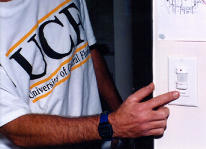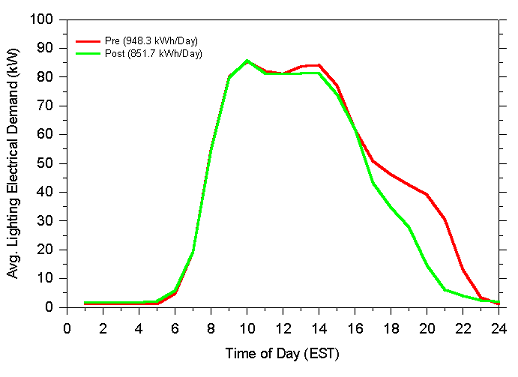
![]()
Automatic Lighting Controls: Northwest Elementary
 Northwest Elementary is a 58,000 ft2 main building and lighting makes up 24%
of the total electrical demand of the school and contributes 23% to the sensible
cooling load. The lighting system originally in place was
a fluorescent T12 lamp-magnetic ballast, but this was retrofit prior to the
study with a T8 lamp-electronic ballast system. Occupancy sensors, which function
to turn lights off when the classroom is unoccupied for a set amount of time
and turn them back on when movement is detected, were implemented
in this project in order to determine the effect of these technologies in reducing
lighting energy consumption and total energy consumption. The project ran from
February 1995 through December 1995. A six month base-line monitoring period
was begun before the school was retrofit with occupancy sensors.
Northwest Elementary is a 58,000 ft2 main building and lighting makes up 24%
of the total electrical demand of the school and contributes 23% to the sensible
cooling load. The lighting system originally in place was
a fluorescent T12 lamp-magnetic ballast, but this was retrofit prior to the
study with a T8 lamp-electronic ballast system. Occupancy sensors, which function
to turn lights off when the classroom is unoccupied for a set amount of time
and turn them back on when movement is detected, were implemented
in this project in order to determine the effect of these technologies in reducing
lighting energy consumption and total energy consumption. The project ran from
February 1995 through December 1995. A six month base-line monitoring period
was begun before the school was retrofit with occupancy sensors.
The school was thoroughly instrumented. Lighting energy use and total energy use was monitored. A meteorological station was set-up to measure air temperature as weather conditions were not likely to affect retrofit measures.
Forty-six passive infrared (PIR) sensors were installed in 33 classrooms,7 offices and a cafeteria. Wall switches and ceiling mounted sensors were used for this project. Classroom sensors were located in corners near the teacher's desk to minimize 'false-offs' (turning off of lights when the room is occupied, which can lead to occupant frustration) when only the teacher was in the classroom.

Average lighting demand savings of 10% realized.
Savings from the retrofit measures were 10.2% (96.8 kWh/school day) in lighting. Pasco County schools, generally, were very diligent in turning off lights when instructors leave classrooms, cafeterias were not in use,and cleaning crews finished for the evening, so these savings could potentially be greater in schools that don't practice energy efficiency as diligently as Pasco County does. When cooling energy use was also included in the analysis, the yearly savings were calculated to be approximately 26,620kWh (19,360 kWh for lighting; 7,260 kWh for cooling loads). The annual estimated savings were $1,694 with a simple payback of 3.6 years (28% rate of return from investment). Most of the savings took place during the evening hours so that the monthly demand charges would be unaffected.
- Full Publication: FSEC-CR-867: Energy Efficiency Technology Demonstration Project for Florida Educational Facilities:Occupancy Sensors
